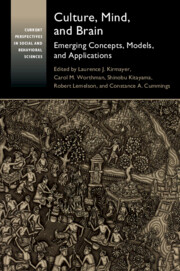Book contents
- Culture, Mind, and Brain
- Current Perspectives in Social and Behavioral Sciences
- Culture, Mind, and Brain
- Copyright page
- Dedication
- Epigraph
- Contents
- Figures
- Tables
- Contributors
- Preface
- Abbreviations
- 1 Introduction
- Part I Dynamics of Culture, Mind, and Brain
- Section 1 The Co-emergence of Culture, Mind, and Brain
- Section 2 The Situated Brain
- 5 Culture in Mind – An Enactivist Account
- 6 The Brain as a Cultural Artifact
- 7 Cultural Priming Effects and the Human Brain
- 8 Culture, Self, and Agency
- Section 3 How Social Coordination and Cooperation are Achieved
- Part II Applications
- Index
- References
8 - Culture, Self, and Agency
An Ecosocial View
from Section 2 - The Situated Brain
Published online by Cambridge University Press: 18 September 2020
- Culture, Mind, and Brain
- Current Perspectives in Social and Behavioral Sciences
- Culture, Mind, and Brain
- Copyright page
- Dedication
- Epigraph
- Contents
- Figures
- Tables
- Contributors
- Preface
- Abbreviations
- 1 Introduction
- Part I Dynamics of Culture, Mind, and Brain
- Section 1 The Co-emergence of Culture, Mind, and Brain
- Section 2 The Situated Brain
- 5 Culture in Mind – An Enactivist Account
- 6 The Brain as a Cultural Artifact
- 7 Cultural Priming Effects and the Human Brain
- 8 Culture, Self, and Agency
- Section 3 How Social Coordination and Cooperation are Achieved
- Part II Applications
- Index
- References
Summary
Agency refers to the human capacity to choose, initiate, and control actions to influence events in the world. The experience of agency is fundamental to our sense of self but may be altered in certain neurological conditions and forms of psychopathology. In this chapter, we review recent work in cognitive neuroscience that shows how agency depends on sensorimotor loops between the body and the environment as well as higher-order processes of attribution and interpretation. The sensorimotor loops that contribute to the sense of agency and ownership of the body and its actions can be manipulated in laboratory experiments to give rise to startling illusions like being out of one’s body, having a rubber hand, or controlling random events. Religious experiences like spirit possession and dissociative symptoms like conversion disorder may depend on attributing action to agencies other than the self. Even everyday actions depend on interpretive processes that draw from cultural affordances and ontologies as well as social and political structures. Embodied experience grounds to the sense of agency, but culturally mediated attributions can alter bodily experience. Far from being simply a consequence of individual cognition or ability, therefore, agency is rooted in ongoing engagement with the social–cultural world.
Keywords
- Type
- Chapter
- Information
- Culture, Mind, and BrainEmerging Concepts, Models, and Applications, pp. 244 - 272Publisher: Cambridge University PressPrint publication year: 2020



